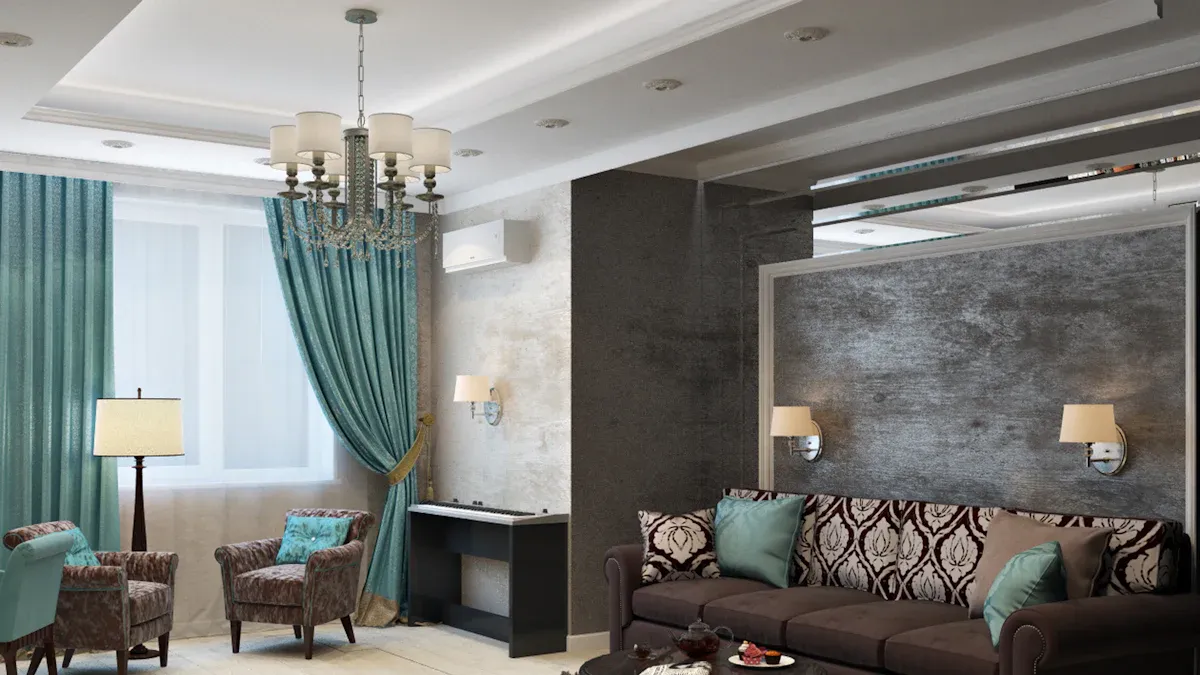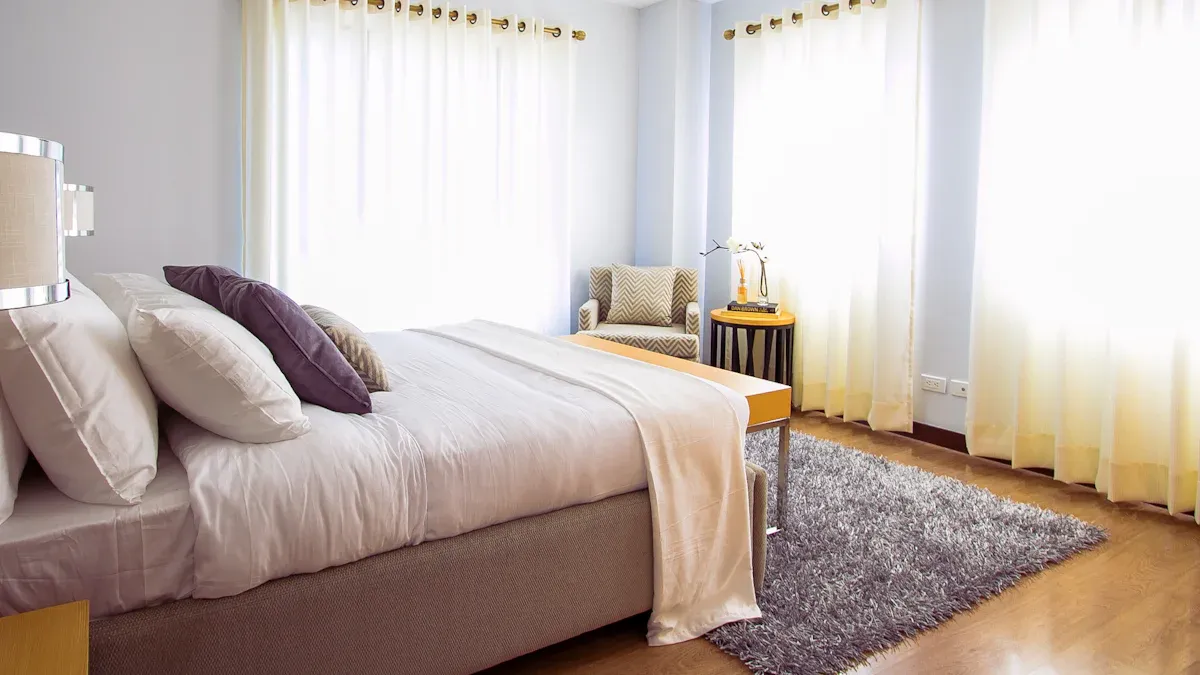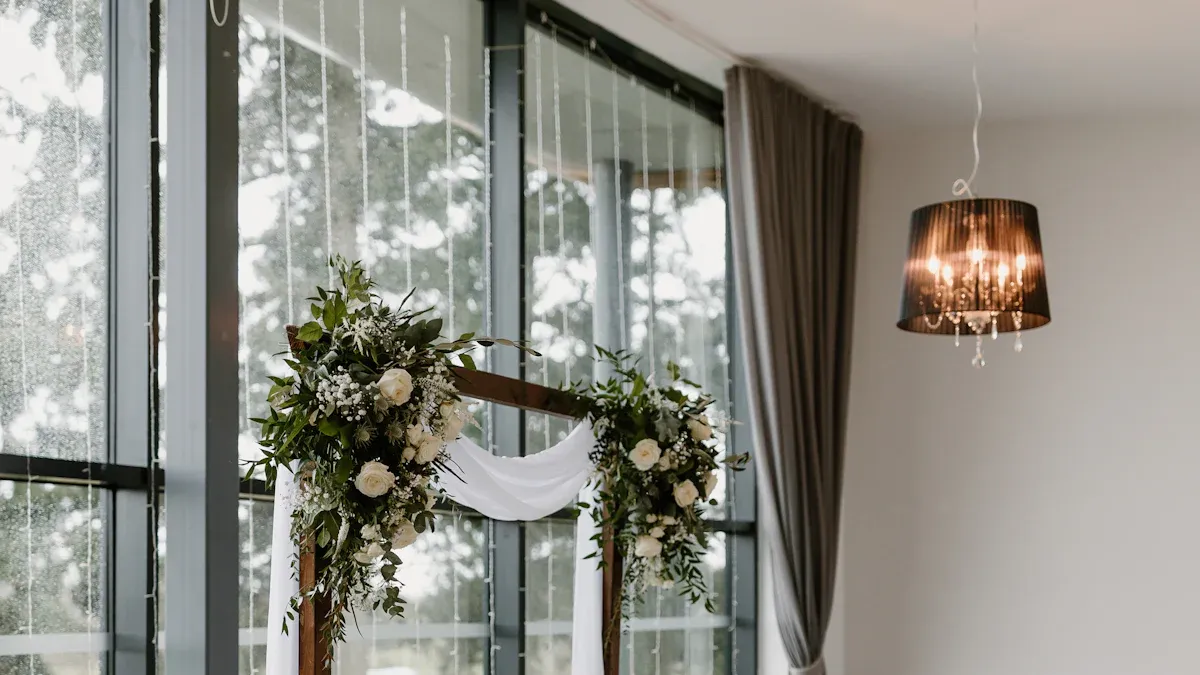
How to Pair Custom Curtains with Blinds and Shades for Style & Function

Combining custom curtains with blinds or shades transforms your windows into a stylish and functional window treatment. This pairing lets you manage light and privacy with ease. For instance, heavier shades block sunlight, while sheer curtains soften the room's ambiance. These layers not only give you control but also add depth to your decor. The mix of textures and colors enhances the room's aesthetic appeal, creating an inviting space that reflects your style. With this approach, you achieve both beauty and practicality in your home.
Key Takeaways
Using curtains with blinds or shades improves style and function. It helps control light and gives more privacy.
Pick fabrics carefully. Thick fabrics block light and keep heat in, while thin fabrics feel light and let sunlight through.
Adding layers to window coverings makes rooms look stylish. Try mixing textures and colors to show your style.
Don't make mistakes like using too many patterns or forgetting functions. Mix looks with usefulness for the best outcome.
In small rooms, use light curtains and small blinds. This keeps the space open but still stylish and cozy.
Why Pair Curtains and Blinds?
Benefits of Combining Curtains with Blinds or Shades
Pairing curtains with blinds or shades offers a perfect balance of functionality and aesthetics. This combination allows you to enjoy the best of both worlds—style and practicality. For example, blinds provide precise light control, while curtains add softness and warmth to your space. Together, they create a cohesive look that enhances your home's decor.
The growing popularity of combining window treatments reflects modern homeowners' desire for elevated style and functionality. Studies show that the residential segment of the curtains and blinds market is expected to grow significantly, driven by increased home renovations and a focus on energy efficiency. This trend highlights how mixing window treatments can meet both practical and decorative needs.
Enhancing Privacy, Light Control, and Insulation
The combination of curtains and blinds offers unmatched privacy and light control. Blinds allow you to adjust the amount of sunlight entering your room, while curtains provide an additional layer of coverage. This pairing ensures you can filter sunlight during the day and enjoy complete privacy at night.
Additionally, combining window treatments improves insulation. Cellular shades, for instance, trap air to reduce heat loss, while curtains add another barrier against temperature changes. This setup not only keeps your home comfortable but also helps lower energy costs.
Adding Depth and Dimension to Your Windows
Arranging curtains and blinds together adds depth and dimension to your windows. The layering effect creates a visually appealing focal point that enhances the overall design of your room. You can experiment with different types of window treatment styles, such as pairing sheer curtains with Roman shades for a classic look or blackout curtains with wooden blinds for a modern touch.
Matching curtains and blinds also allow you to play with colors, patterns, and textures. This flexibility lets you customize your window treatments to reflect your style. Whether you prefer a minimalist design or a bold statement, the combination of curtains and blinds can transform your space into something truly unique.
Choosing the Right Curtains and Blinds
Selecting Fabrics and Materials for Custom Curtains
When selecting fabrics for custom curtains, you should consider both style and functionality. The fabric you choose can influence how your draperies hang, their durability, and their overall appearance. For a structured look, medium-weight cotton works well, especially for goblet or inverted pleat curtains. If you prefer versatility, polyester-cotton blends offer durability and suit various styles. For a luxurious feel, velvet or faux suede adds elegance and insulation, making them ideal for formal settings.
Different fabrics also serve specific purposes. For instance, heavy damasks retain heat and block sunlight, making them perfect for winter. On the other hand, faux silks provide a lighter look and natural movement, ideal for lightweight sheers or tab-top curtains. You should also think about the impact of sunlight on fabric color. Natural fibers like cotton or linen create an airy atmosphere but may fade in direct sunlight. Lined fabrics enhance thermal properties and light control, making them a practical choice for any room.
Fabric Type |
Characteristics |
Best Use Cases |
|---|---|---|
Medium weight cotton |
Rigid, hangs correctly for structured looks |
Goblet or inverted pleat curtains |
Polyester-cotton blends |
Offers durability and structure |
Versatile for various styles |
Faux silks |
Provides a lighter look and natural movement |
Tab top curtains, lightweight sheers |
Heavy to medium weight Damasks |
Retains heat and blocks sunlight |
Winter curtains |
Velvet and faux suede |
Insulating properties adds luxury feel |
Formal settings |
Natural colors |
Less prone to fading, suits most color schemes |
Sunlit rooms |
Lined fabrics |
Enhances thermal properties and light control |
Any fabric type for better insulation |
Choosing Blinds or Shades to Complement Your Curtains
Blinds and shades play a crucial role in matching curtains with shades or draperies. When choosing the right option, think about the functionality you need. For precise light control, blinds like Venetian or vertical styles work well. If you want a softer look, Roman shades or cellular shades are excellent choices. Cellular shades also improve insulation, making them energy-efficient.
The material of your blinds or shades should complement your curtains. Wooden blinds pair beautifully with heavy draperies, creating a warm and inviting atmosphere. For a modern touch, metal or faux wood blinds work well with lighter fabrics. Roman shades, with their timeless appeal, blend seamlessly with sheer or blackout curtains, offering both style and practicality.
Coordinating Colors, Patterns, and Textures
Coordinating colors, patterns, and textures is key to achieving a cohesive look. Start by choosing a color palette that ties together the elements in your room. Neutral tones create a soothing backdrop, while bold colors add visual interest. If your curtains feature intricate patterns, opt for solid-colored blinds or shades to balance the design.
Textures also play a significant role. Pairing smooth Roman shades with textured draperies, like velvet or linen, adds depth to your windows. Alternatively, you can match wooden blinds with cotton or linen curtains for a natural, earthy vibe. Always consider the overall theme of your room when coordinating these elements. This ensures your window treatments enhance the space rather than overpower it.
How to Layer Window Treatments

Layering for a Minimalist Look
Minimalist layering focuses on simplicity and functionality. To achieve this, you can pair sheer draperies with sleek blinds or shades. Sheer draperies soften the look of your windows while allowing natural light to filter through. Blinds, such as Roman or cellular shades, provide privacy and light control without overwhelming the space. This combination creates a clean and airy aesthetic.
Design portfolios from Studio McGee and Norm Architects highlight how layering draperies with blinds enhances a minimalist style. They use soft, neutral colors and subtle textures to add depth without cluttering the room. You can replicate this by choosing light fabrics like linen or cotton for your draperies and pairing them with shades in complementary tones. This approach ensures your windows remain functional and stylish.
Creating a Luxurious, Full-Draped Effect
For a more opulent look, consider combining draperies with soft window treatments like Roman shades. Start with heavy draperies made of velvet or damask to frame your windows. Add Roman shades in a coordinating color or pattern for a layered effect that exudes elegance. This pairing not only enhances the visual appeal but also improves insulation and noise reduction.
Layered window treatments offer design flexibility, allowing you to mix textures and materials. For instance, you can put curtains over blinds to create a dramatic effect. Wooden blinds paired with rich draperies add warmth and sophistication to your space. This combination works well in formal living rooms or master bedrooms where you want to make a statement.
Practical Tips for Layering in Small Spaces
Layering in small spaces requires careful planning to avoid overwhelming the room. Opt for lightweight draperies and compact blinds to maintain a sense of openness. Sheer draperies paired with roller shades work well in tight areas, offering privacy without adding bulk. Choose the right layer window treatments by sticking to neutral colors and simple patterns that blend seamlessly with your decor.
Frama's design portfolio demonstrates how combining soft and hard window treatments can maximize functionality in small spaces. They use close-up views of textures and materials to show how layering can create depth without clutter. You can achieve this by selecting draperies with subtle textures and pairing them with slim-profile blinds. This ensures your windows look stylish while saving space.
Tip: When layering draperies in small rooms, use ceiling-mounted curtain rods to create the illusion of taller windows.
Stylish and Functional Window Treatment Tips by Room

Living Rooms: Balancing Style and Comfort
Your living room serves as the heart of your home, where style meets comfort. To achieve this balance, pair curtains and blinds that enhance both functionality and aesthetics. Thermal blinds help regulate temperature, keeping your space cozy in winter and cool in summer. Retractable shades allow you to enjoy unobstructed views while maintaining privacy. For a welcoming ambiance, choose draperies made from light-transmitting materials that diffuse sunlight beautifully.
Durability is essential in high-traffic areas like the living room. Opt for robust materials that are easy to clean and maintain. Cordless or motorized blinds not only add a modern touch but also improve safety, especially in homes with children or pets. Incorporating feng shui principles, such as maximizing natural light and adding plants, can further enhance the room's comfort and emotional appeal.
Bedrooms: Maximizing Privacy and Light Blocking
Your bedroom should be a sanctuary for rest and relaxation. The right window treatments can create a restful environment by managing sunlight and ensuring privacy. Blackout shades are an excellent choice for blocking light, helping you sleep better. Layering sheer draperies with heavier curtains allows you to adjust light levels throughout the day while adding a touch of elegance.
For smaller windows, blinds offer adaptability and effective light control. Roman shades, paired with custom curtains, provide a stylish yet functional solution. This combination not only enhances privacy but also adds depth to your bedroom decor. By choosing the right materials and layering techniques, you can transform your bedroom into a serene retreat.
Kitchens and Bathrooms: Choosing Moisture-Resistant Options
Kitchens and bathrooms require window treatments that can withstand humidity and moisture. Man-made materials, such as faux wood or vinyl, are ideal for these spaces. Hunter Douglas EverWood® blinds combine the aesthetic appeal of wood with moisture-resistant properties, ensuring they remain hygienic and easy to maintain. These blinds resist warping, cracking, and peeling, making them a practical choice for busy households.
When selecting draperies or shades for these areas, consider comparing samples in the actual space to ensure they complement your decor. Roller shades made from waterproof materials work well in kitchens, while woven shades add texture to bathrooms. By choosing moisture-resistant options, you can enjoy stylish and functional window treatments that last.
Common Mistakes When You Pair Curtains and Blinds
Overloading with Too Many Patterns or Colors
Using too many patterns or colors in your window treatments can overwhelm the room. While it's tempting to mix bold designs, this approach often creates visual chaos rather than harmony. For example, pairing patterned curtains with brightly colored blinds or shades can clash and distract from the overall decor. Instead, aim for balance by choosing one dominant pattern and complementing it with solid or neutral tones.
Design critiques highlight that excessive patterns or colors can confuse the eye and dilute the room's aesthetic. A cluttered look not only disrupts visual harmony but also makes the space feel smaller and less inviting. To avoid this, stick to a cohesive color palette and limit bold patterns to one element, such as the curtains or the shades. This approach ensures your window treatments enhance the room rather than overpower it.
Ignoring Functionality for Style
Prioritizing style over functionality is another common mistake. While it's important to choose attractive window treatments, they should also meet your practical needs. For instance, selecting sheer curtains for a bedroom might look elegant but won't provide adequate privacy or light blocking. Similarly, using heavy drapes in a kitchen can trap odors and moisture, making them impractical for the space.
When pairing curtains with blinds or shades, consider how they will function together. Blinds offer precise light control, while shades like cellular options improve insulation. Combining these with curtains allows you to achieve both style and practicality. Always evaluate the purpose of the room and choose treatments that align with its requirements.
Choosing the Wrong Size or Length for Curtains
Incorrect sizing can ruin the appearance of your window treatments. Curtains that are too short or narrow disrupt the room's proportions and make the design look unintentional. To avoid this, measure carefully and follow expert recommendations. For a lush, full look, choose curtains that are 2 to 2.5 times the width of the window. This ensures the panels provide adequate coverage and visual balance.
Curtain length is equally important. Panels that barely reach the windowsill or pool excessively on the floor can appear awkward. For a polished look, ensure the curtains either skim the floor or puddle slightly, depending on your style preference. Uneven floors can also affect the appearance, so adjust the length accordingly to maintain symmetry. Pairing well-sized curtains with blinds or shades creates a cohesive and intentional design.
Tip: Always test fabric samples in your space to ensure the colors and textures complement your decor.
Pairing custom curtains with blinds or shades transforms your windows into a blend of style and functionality. This combination enhances privacy, light control, and insulation while adding depth and texture to your decor. Experts agree that layering window treatments creates a harmonious balance of softness and practicality, elevating your room's aesthetics. Experiment with different combinations to find the perfect match for your space. For tailored solutions, consult professionals or explore Freshine's collection of premium window treatments designed to meet your unique needs.
FAQ
What are the best types of blinds to pair with curtains?
You can pair Roman blinds with sheer curtains for a classic look or wooden blinds with heavy draperies for a modern touch. Cellular shades also work well with curtains, offering insulation and light control. Choose blinds that complement your curtains' style and functionality.
How do you choose the right shades for a minimalist design?
For a minimalist look, select shades with clean lines and neutral colors. Roller shades or cellular shades work best. Pair them with lightweight curtains in complementary tones to maintain simplicity and elegance. Avoid bold patterns or heavy textures.
Can you mix patterns when pairing curtains and blinds?
Yes, but balance is key. If your curtains have bold patterns, choose solid-colored blinds. Alternatively, pair subtle patterns on both for a cohesive look. Always ensure the colors and designs harmonize with the room's overall decor.
How do layered window treatments improve insulation?
Layering curtains with cellular shades or thermal blinds creates an effective barrier against temperature changes. Cellular shades trap air, while curtains add an extra layer of insulation. This combination helps maintain a comfortable indoor climate and reduces energy costs.
Are blinds or shades better for small spaces?
Shades are often better for small spaces due to their compact design. Roller shades or Roman shades save space while providing privacy and light control. Pair them with lightweight curtains to avoid overwhelming the room.










